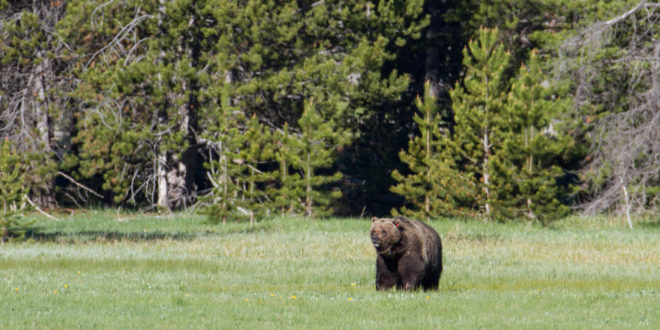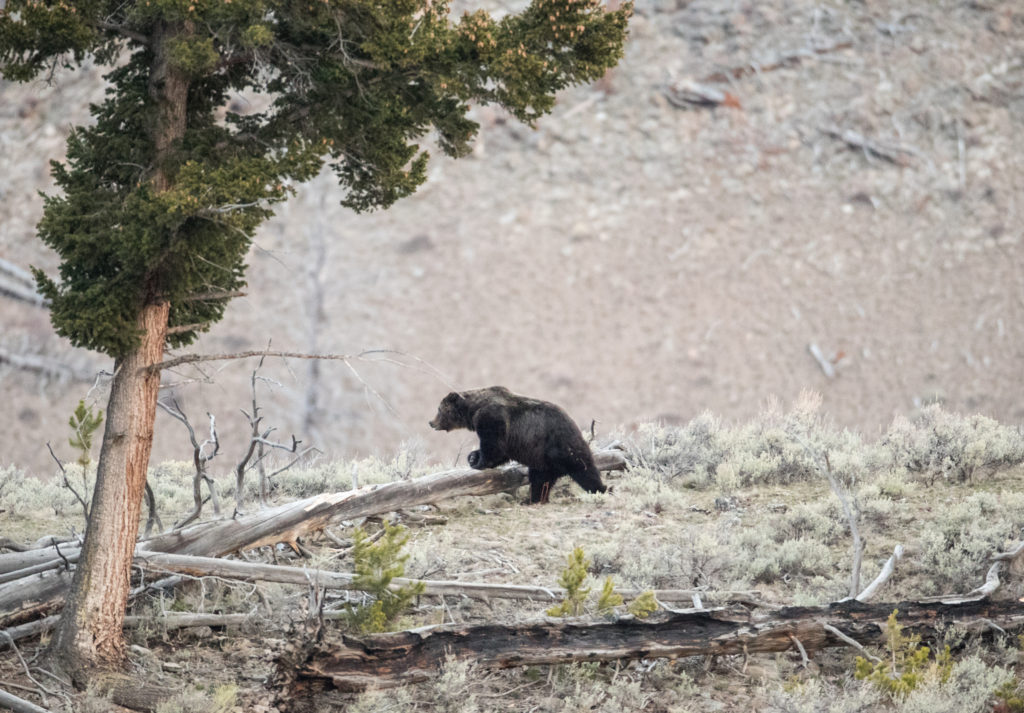The Yellowstone grizzly population is relatively stable, according to estimates from the Interagency Grizzly Bear Study Team (IGBST).
The news comes with state agencies, rather than the federal government, at the helm of grizzly management, after the bears were delisted from the Endangered Species List this summer.
According to IGBST leader Frank van Manen, speaking with the Bozeman Daily Chronicle, an estimated 718 grizzlies currently live in the 19,279-square-mile monitoring area (established under the delisting protocol) in/around Yellowstone National Park. That number is up slightly from last year (695 bears) but according to van Manen it doesn’t signify a trend. From the Chronicle:
“It’s still pretty much within the same realm,” he said. “In reality, it’s pretty stable.”
Van Manen presented the numbers at the inaugural meeting of the Yellowstone Grizzly Coordinating Committee, a body of 19 state, federal and tribal officials charged with overseeing grizzly management now that the animal is no longer listed as threatened under the Endangered Species Act.
Yellowstone’s grizzly bears were first listed as threatened in 1975, when they numbered fewer than 150. Bear managers have long felt the species is recovered, and in June, Interior Secretary Ryan Zinke lifted the protections from the bears.
The move shifted more management responsibility to the states of Montana, Idaho and Wyoming, and it also opened the door for state-managed grizzly bear hunts. No hunts have been planned so far.
Although no states have announced formal hunting plans yet, the possibility has come up among wildlife officials, according to ABC News:
Hunting is part of the states’ grizzly management strategy. But details have yet to be worked out and state officials have consistently said any hunts would be limited to a small number of bears so as not to endanger the overall population.
“None of the states at this point in time are actively planning for hunts, but they are beginning dialogues with various members of the public about what that would look like” said Gregg Losinksi with Idaho Fish and Game.
Montana Fish Wildlife and Parks spokesman Greg Lemon said Montana officials are focused on building public trust on grizzly management. There are no active discussions about future hunts in the state, Lemon said.
We previously reported the Wyoming Game and Fish Department would host information meetings about grizzly management around the state through November and early December. Dan Thompson, large carnivore section supervisor for the Department, said the meetings were meant to solicit input from the community. As with Idaho and Montana’s wildlife agencies, Wyoming has not committed to a formal hunt. Wyoming has the largest share of grizzlies to manage outside of Yellowstone National Park.
There is still a grizzly meeting planned for Monday, December 4, 2017 at 6 p.m. at the Inn at Lander in Lander, Wyoming.
ABC News also reports the National Rifle Association and Safari Club International have asked the judge overseeing litigation against the USFWS’s delisting decision for “permission to intervene,” arguing they want members to have a chance at hunting grizzlies, should agencies decide to institute hunts.
Yellowstone grizzlies were delisted in June this year, following nearly two years of debate and analysis. Management was transferred from the U.S. Fish and Wildlife Service (USFWS) to state wildlife agencies in August 2017.
Six lawsuits have been filed this year in response to the delisting decision. According to the Chronicle, it is expected that these suits will be combined over the coming months. Most of the suits have been filed by advocacy groups like the Center for Biological Diversity and Western Environmental Law Center. One suit that stands out is one filed by a coalition of Native American tribes, who contest the Yellowstone grizzly delisting decision on religious grounds.
The Yellowstone grizzly population was previously delisted in 2007, but protections were reinstated in 2009 when a federal judge found the USFWS had not adequately considered the impact of climate change on important bear food sources like whitebark pine.
According to the Chronicle, the Yellowstone Grizzly Coordinating Committee will meet today, December 1, 2017, to discuss conservation strategies for the Yellowstone grizzly. As mentioned, they previously met this week to discuss rules and regulations, although according to the Chronicle, tribal reps were not at the meeting:
The group spent much of the meeting finalizing its rules, including a requirement that three-fourths of the body must agree on any change to the conservation strategy — like adjusting kill limits or changing how bears are counted.
The strategy says managers should aim for a population of roughly 674 bears within the monitoring area. It also includes limits on how many bears can be killed by managers or hunters within that area. The limits are based on the population estimate and are broken down by sex and age.
Van Manen said 46 bears have died within that area so far this year. Four have died outside of the area.
The total of 50 is lower than in the last few years. Most of the kills were human caused, many of them coming after run-ins between bears and hunters.
“Hunting-related mortality was higher this year than we have seen on average in the previous decade,” van Manen said.
The Chronicle also reports that the real Yellowstone grizzly count could actually be upwards of 1,000, owing to the conservative nature of the IGBST’s counting method.
Indeed, Yellowstone Superintendent Dan Wenk and a researcher at the University of Montana have criticized the conservativeness of the IGBST’s count, saying it goes against the “best available science” requirement in assessing grizzly management strategies. Others, according to the Chronicle, fear the IGBST’s estimate is actually too low.
Besides an opposition to hunting, grizzly advocates argue Yellowstone grizzlies have not fully recovered because they have not returned to their historic ranges or established “connectivity” with other populations. Indeed, the Yellowstone grizzly population can be considered a “biogeographic island,” since bears are limited in terms of where they can expand without coming into conflict with people or exposing themselves to unique dangers e.g. getting struck by cars on the highway.
That being said, more bears have been seen wandering outside Yellowstone National Park, especially in Wyoming. Meanwhile, in Montana, a new study has predicted several ways Yellowstone grizzly bears could reconnect with their cohorts in the Northern Continental Divide Ecosystem in the north part of the state.
Establishing connectivity, advocates argue, would diversify the population and give grizzlies in Montana/Wyoming a better shot at staying stable or even expanding further from their islands.
 Yellowstone Insider Your Complete Guide to America's First National Park
Yellowstone Insider Your Complete Guide to America's First National Park







You must be logged in to post a comment.